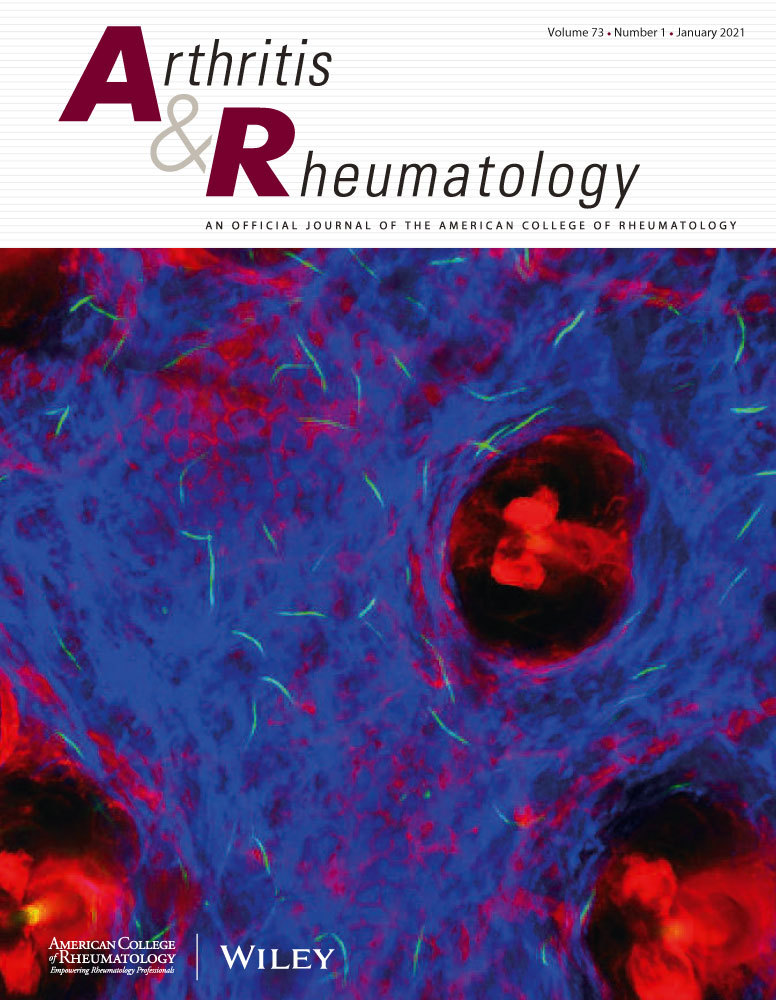Three-Year Outcomes and Latent Class Trajectory Analysis of the Childhood Arthritis and Rheumatology Research Alliance Polyarticular JIA Consensus Treatment Plans Study.
IF 11.4
1区 医学
Q1 RHEUMATOLOGY
引用次数: 0
Abstract
OBJECTIVE To assess the impact of differences in the timing of initial biologic DMARD (bDMARD) therapy using the CARRA STOP-JIA polyarticular JIA (pJIA) consensus treatment plans (CTPs) study on outcomes through 3 years. METHODS STOP-JIA participants with CARRA Registry follow-up through 3 years were eligible. Outcomes included ACR clinically inactive disease (CID) off glucocorticoids, clinical Juvenile Arthritis Disease Activity Score (10 joints) inactive disease (cJADAS-10-ID: cJADAS-10≤2.5), clinical remission on medication (CRM), and proportion of time in CID and/or cJADAS-10-ID. Latent class trajectory modeling (LCTM) was applied to identify participant subgroups sharing similar disease courses over this period. RESULTS 297 participants were included (n=190 Step Up [SU], 76 Early Combination [EC], 31 Biologic First [BF]). At the 3-year visit, CID was achieved by 35%, 42% and 44%, respectively (p=0.35 for SU versus EC). EC was superior to SU in achieving CRM (59.9% vs. 40.6%; p=0.012), time spent in CID (38% versus 30%; p=0.04) and cJADAS-10-ID (51% versus 41%; p=0.02). Slow, moderate, and rapid improvement trajectories were identified by LCTM; bDMARD initiation within the first (OR 5.33) or second (OR 2.67) month from baseline was associated with the rapid improvement trajectory. CONCLUSIONS EC was superior to SU across 3 years for outcomes reflecting time spent in lower disease activity. Starting bDMARD within 2 months predicted rapid improvement and maintenance of inactive disease. These results support the hypothesis that early bDMARD initiation reduces overall disease burden in pJIA.儿童关节炎和风湿病研究联盟多关节JIA共识治疗方案研究的三年结局和潜在类别轨迹分析
目的通过CARRA停止-JIA多关节JIA (pJIA)共识治疗计划(ctp)研究,评估初始生物DMARD (bDMARD)治疗时间差异对3年预后的影响。方法经CARRA注册中心随访3年的stop - jia参与者符合条件。结果包括ACR临床无活性疾病(CID)停用糖皮质激素,临床青少年关节炎疾病活动评分(10个关节)无活性疾病(cJADAS-10- id: cJADAS-10≤2.5),临床药物缓解(CRM), CID和/或cJADAS-10- id的时间比例。应用潜在类轨迹模型(LCTM)来确定在此期间具有相似疾病病程的参与者亚组。结果共纳入297例受试者,其中Step Up [SU] 190例,Early Combination [EC] 76例,Biologic First [BF] 31例。在3年的随访中,CID分别达到35%、42%和44% (SU与EC的p=0.35)。EC在实现客户关系管理方面优于SU (59.9% vs 40.6%;p=0.012),在CID中花费的时间(38% vs 30%;p=0.04)和cJADAS-10-ID (51% vs 41%;p = 0.02)。LCTM确定了缓慢、中等和快速的改善轨迹;从基线开始的第一个月(OR 5.33)或第二个月(OR 2.67)内启动bDMARD与快速改善轨迹相关。结论:在反映疾病活动性降低时间的结果方面,sec优于SU。在2个月内开始bDMARD预示着非活动性疾病的快速改善和维持。这些结果支持了早期bDMARD启动降低pJIA总体疾病负担的假设。
本文章由计算机程序翻译,如有差异,请以英文原文为准。
求助全文
约1分钟内获得全文
求助全文
来源期刊

Arthritis & Rheumatology
RHEUMATOLOGY-
CiteScore
20.90
自引率
3.00%
发文量
371
期刊介绍:
Arthritis & Rheumatology is the official journal of the American College of Rheumatology and focuses on the natural history, pathophysiology, treatment, and outcome of rheumatic diseases. It is a peer-reviewed publication that aims to provide the highest quality basic and clinical research in this field. The journal covers a wide range of investigative areas and also includes review articles, editorials, and educational material for researchers and clinicians. Being recognized as a leading research journal in rheumatology, Arthritis & Rheumatology serves the global community of rheumatology investigators and clinicians.
 求助内容:
求助内容: 应助结果提醒方式:
应助结果提醒方式:


